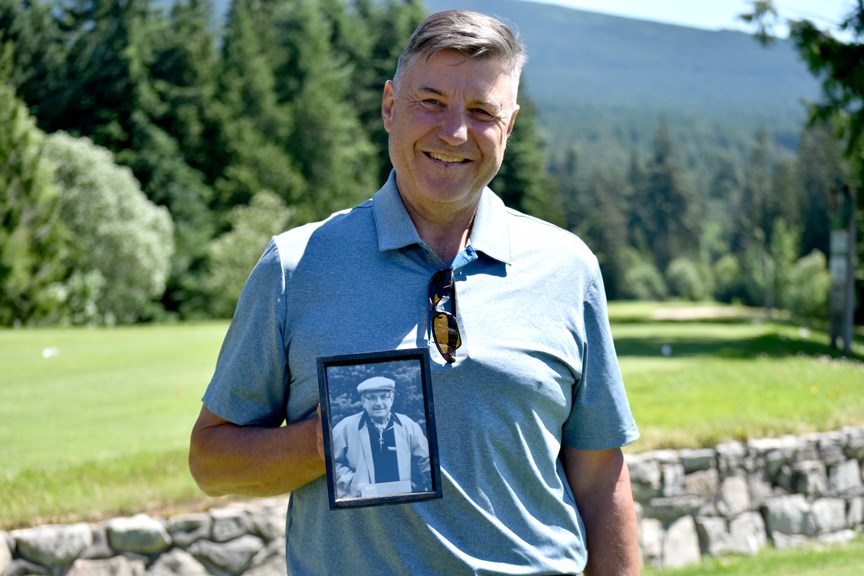Mill workers were among the original members of the Sunshine Coast’s first golf course. Five decades later, they’re still swinging clubs.
“Back in the day, golf courses and country clubs were thought of … for the rich and famous and out of reach for your average working person, but that actually couldn’t be further from the truth for this club,” said Patrick Gaines, president of the Sunshine Coast Golf and Country Club, which celebrated its 50th anniversary on June 1.
At a boardroom in the clubhouse, Gaines pores over photo albums containing newspaper clippings and black-and-white images of the hardscrabble labourers and prosperous business owners who collaborated to bring golf to the Coast in the early 1960s.
It’s not just the working-class membership that separates this club from others, according to Gaines. The club is incorporated as a non-profit society earning enough revenue to cover the more than $1 million payroll for its approximately 40 employees, but it relies heavily on volunteers – at least twice as many people help maintain the club, which doubles as an events venue. Last year 150 non-member events took place on its grounds, serving 8,000 dishes in November and December alone.
The club’s local roots are also a key to its success, said Gaines. Planning for the course began in the 1960s. A small group met at the SuperValu in Gibsons and Parker’s Hardware store in Sechelt to figure out fundraising. Their vision was to bring more recreational opportunities to the Coast, which at that time was mainly limited to a few schoolyards.
In those days, the largest business concerns on the Coast were grocery stores.
Dick Clayton was the first treasurer while SuperValu’s Keith Wright and Ed Matthews assisted with administrative planning, with help from golf enthusiasts in North Vancouver enamoured with the idea of a Roberts Creek course.
“We did all the hard work, raised the money, they helped smooth our landing,” said Gaines.
The course exists thanks in large part to a gift from Wilma and Walter Morrison. The farmers donated more than 50 acres of their homestead to the cause. It was on this land that the first nine-hole course was built for an anticipated cost of $70,000. Wilma remains a lifetime member. The Walter Morrison Mixed Member Tournament is named in honour of her deceased husband.
The club started out with 300 members, almost entirely local. “It was thriving. There was more than just golf,” said former president Greg Johnston. Social events took place up to four evenings a week, with volunteers taking turns at the bar and in the kitchen. “This was grassroots,” said Gaines.
By the 1970s, membership had doubled and the nine-hole course was overrun. “At 600 members it was just untenable to continue that way,” said Gaines.
By 1985, the process of adding the extra nine holes began and was completed more than 20 years later. It required considerable consultation with the community, since by then Cliff Gilker Park, which runs alongside the course, had been established and the mix of private and Crown land created a complicated purchasing process. Community members were concerned about the environment. Salmon-bearing streams flowed through the proposed expansion area.
“There was local discussion about that, for sure,” said Gaines. The club responded by creating an environmental plan, among the first Canadian clubs to do so. “We had to make sure our environmental practices were leading edge, and that came about through discussions with the community,” said Gaines. “I don’t think there’s a course that in 1995 was progressive as this one.”
Now a walking trail circles the course, accessible through Cliff Gilker, and the club uses its own water supply.
Despite the expansion, membership has settled back to about 300, mostly comprising locals. It took a hit after the 2008 financial crisis and its board is working to build membership back up. They also rely more on seasonal visitors. Another challenge facing the club is the Sunshine Coast’s unique demographic, which skews older than the provincial average.
“We have more people aging out of the game than, say, your average golf course does,” said Gaines.
To curb those losses, the club is investing heavily in the next generation of golfers. Last year it hosted the Western Regional Juvenile Tournament and its annual pro-am tournament raises money for promising junior players, four of which are playing at post-secondary institutions across Canada and the U.S.
“It says on the sign down there, ‘Everyone welcome,’ and everyone is welcome,” said Gaines. Everyone is welcome to join them in celebrating its 50th anniversary at a June 29 celebration at the club.


